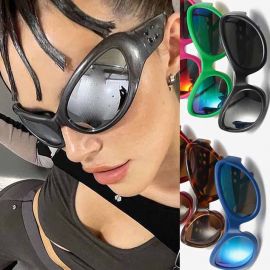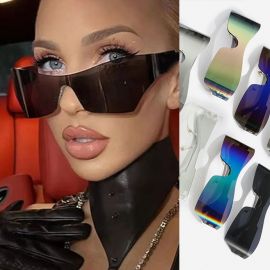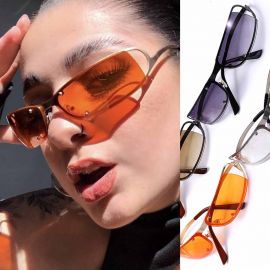When do wraparound sunglasses fit you best?
Wrap-around sunglasses hug the contours of your face, preventing the sun’s rays from creeping in around the edges. That cuts down on the glare and bright spots that obscure your vision when you’re outdoors.
Wrap-arounds are a practical alternative to fashion sunglasses, which can make you look cool, detached or edgy. Alas, these virtues can’t mask the vices of many fashion shades: They let too much sun in.
Doesn’t that defeat the purpose of wearing sunglasses? Possibly, but since when does fashion have to make sense?
Wrap-arounds serve different purposes. Some provide a low cost alternative to prescription sunglasses, while others help outdoor athletes and workers see the world more clearly.
These answers to frequently asked questions will help you figure out which ones are right for you:
When are wrap-around sunglasses over glasses a good option?
Sunglasses that sit on top of a pair of prescription eyeglasses are the most basic and economical variety of wrap-arounds. Sometimes they’re called fit-overs or wrap-overs.
You’re forgiven for thinking of them as wrap-around sunglasses for seniors. Sure, elderly people are more likely to have prescription eyeglasses because everybody’s eyesight fades with age. And perhaps people in their golden years would rather not buy prescription wrap-around sunglasses.
It turns out, however, that all sorts of people who wear prescription eyeglasses are candidates for fit-over or wrap-over sunglasses, which don’t cost much and block far more sun than a pair of clip-on sunglass lenses would.
Wrap-around sunglasses over glasses do pose a few challenges:
-
They add weight, so they might not be comfortable to wear for hours on end.
-
Because they sit on existing glasses, they probably won’t stay in place for motion-heavy activities.
-
You have to carefully measure your prescription glasses to make sure they’ll fit under these wrap-over sunglasses. (This is more of a challenge when ordering online. If you’re buying in a store, you can just try them on.)
Wrap-around sunglasses that go over glasses often are available with polarized lenses, so they’re good for reducing glare near the ocean or while driving.
From here on in, we’ll talk about the rest of the wrap-around sunglasses on the market.
Are wrap-around sunglasses better than other styles?
Wrap-around shades might not always be better, but they’ll always be practical — especially if you need to keep your vision sharp amid extremely bright light.
Celebrities and retired sports stars wear wrap-arounds to the Oscars and the Super Bowl for utilitarian reasons: paparazzi flash mobs.
Some wrap-around sunglasses lack the subtlety and nuance of more laid-back styles. They might have an aggressive, athletic sensibility that doesn’t mesh with the rest of your wardrobe.
Wrap-around sunglasses may look better on people with certain face shapes, but they’re best to have a job done.
Who should wear wrap-around sunglasses?
Wrap-arounds are essential if you work or play in the direct sun and can’t shade the area around your eyes. If you have a broad-brimmed hat for hiking or a Stetson-style cowboy hat for horseback riding, you’ll probably get enough shade to make do with conventional sunglass styles.
But if you take a dirt bike or an ATV out for all-day adventures, you’re more likely to need a helmet that doesn’t provide much shade. The same holds for working in hard-hat areas on construction sites or any kind of industrial job that exposes you to the sun or intense indoor lights.
Wrap-around sunglasses also can feel like a lifesaver if you have light sensitive eyes.
What are shield sunglasses?
Shield sunglasses have a one-piece lens that stretches all the way across the visual field. They’re sort of a crossbreed between sunglasses and ski goggles. Shield sunglasses generally have one lens and two temple arms, while goggles have an elastic band to keep them in place.
Why don't we just get goggles? Well, tumbling down a hillside is part of the fun of snow sports. That’s why goggles need an elastic band. If spills are rare (golf springs to mind), then shield-style sunglasses make more sense.
Shopping tips for wrap-around sunglasses
-
Look for styles that fit how you’ll wear them. Make sure you’re getting enough peripheral vision and the frames won’t block your field of view when you need it most.
-
Prescription wraparound styles are available — For instance, Oakley prescription sunglasses include wraparound styles. Just keep in mind that the curves in wraparound glasses limit your prescription options. It’s best to consult an optician to find sunglasses that are compatible with the refraction your prescription requires.
-
Polarization may not be ideal for every outdoor activity. Polarization can reduce depth perception, which can make it tough to spot a patch of ice on a ski slope. If you’re not sure, ask your fellow competitors for their experience with polarized lenses.
Above all, spend prudently. You can use hundreds of dollars on high-tech wrap-around sunglasses, but you don’t have to. Do your research, ask people you trust and match your purchases with your practical needs.



